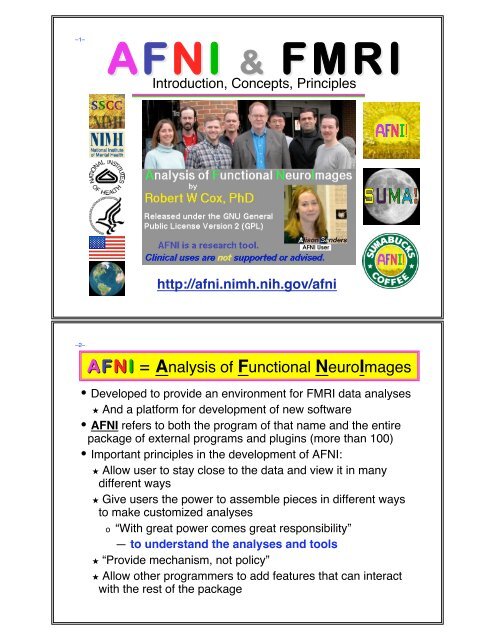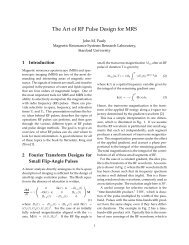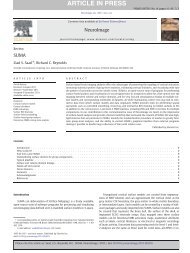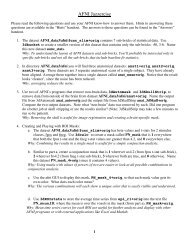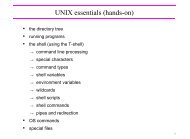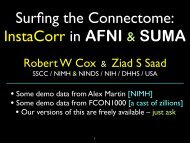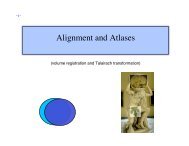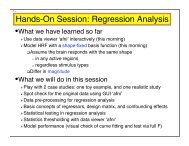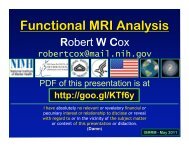You also want an ePaper? Increase the reach of your titles
YUMPU automatically turns print PDFs into web optimized ePapers that Google loves.
–9–Precession of Magnetization M• Magnetic field B causes M to rotate (“precess”) about <strong>the</strong>direction of B at a frequency proportional to <strong>the</strong> size of B —42 million times per second (42 MHz), per Tesla of B! 127 MHz at B = 3 Tesla — range of radio frequencies" If M is not parallel to B, <strong>the</strong>nit precesses clockwise around<strong>the</strong> direction of B." However, “normal” (fully relaxed)situation has M parallel to B, whichmeans <strong>the</strong>re won’t be anyprecession" N.B.: part of M parallel to B (M z )does not precess–10–B 1 = Excitation (Transmitted) RF Field• Left alone, M will align itself with B in about 2–3 s! $ No precession $ no detectable signal• So don’t leave it alone: apply (transmit) a magnetic fieldB 1 that fluctuates at <strong>the</strong> precession frequency (radiofrequency=RF) and points perpendicular to B 0" The effect of <strong>the</strong> tiny B 1 isto cause M to spiral awayfrom <strong>the</strong> direction of <strong>the</strong>static B field" B 1 #10 –4 Tesla" This is called resonance" If B 1 frequency is not close toresonance, B 1 has no effectTime = 2–4 ms
–11–Readout RF• When excitation RF is turned off, M is leftpointed off at some angle to B 0 [flip angle]• Precessing part of M [M xy ] is like having a magnet rotatingaround at very high speed (at RF speed: millions of revs/second)• Will generate an oscillating voltage in a coil of wires placedaround <strong>the</strong> subject — this is magnetic induction• This voltage is <strong>the</strong> RF signal = <strong>the</strong> raw data for MRI• At each instant t, can measure one voltage V(t), which isproportional to <strong>the</strong> sum of all transverse M xy inside <strong>the</strong> coil• Must separate signals originating from different regions• By reading out data for 5-60 ms, manipulating B field, being clever …• Then have image of M xy = map of how much signal from each voxel–12–Relaxation: Nothing Lasts Forever• In <strong>the</strong> absence of external B 1 , M will go back tobeing aligned with static field B 0 = relaxation• Part of M perpendicular to B 0 shrinks [M xy ]! This part of M = transverse magnetization! It generates <strong>the</strong> detectable RF signal! The relaxation of M xy during readout affects<strong>the</strong> image• Part of M parallel to B 0 grows back [M z ]! This part of M = longitudinal magnetization! Not directly detectable, but is converted intotransverse magnetization by external B 1o Therefore, M z is <strong>the</strong> ultimate source of <strong>the</strong> NMRsignal, but is not <strong>the</strong> proximate source of <strong>the</strong> signalTime scalefor this relaxationis called T2 or T2 *= 20-40 ms in brainTime scalefor this relaxationis called T1= 500-2500 ms
–13–Material Induced Inhomogeneities in B• Adding a nonuniform object (like a person) to B 0 will make <strong>the</strong> totalmagnetic field B nonuniform! This is due to susceptibility: generation of extra magnetic fields inmaterials that are immersed in an external field! Diamagnetic materials produce negative B fields [most tissue]! Paramagnetic materials produce positive B fields[deoxyhemoglobin]! Size of changes about 10 –7 %B 0 = 1–100 Hz change in precession f• Makes <strong>the</strong> precession frequency nonuniform, which affects <strong>the</strong> imageintensity and quality! For large scale (100+ mm) inhomogeneities, scanner-suppliednonuniform magnetic fields can be adjusted to “even out” <strong>the</strong>ripples in B — this is called shimming! Nonuniformities in B bigger than voxel size distort whole image! Nonuniformities in B smaller than voxel size affect voxel“brightness”–14–The Concept of Contrast (or Weighting)• Contrast = difference in RF signals — emitted by waterprotons — between different tissues• Example: gray-white contrast is possible because T1 isdifferent between <strong>the</strong>se two types of tissue
–15–Types of Contrast Used in Brain <strong>FMRI</strong>• T1 contrast at high spatial resolution! Technique: use very short timing between RF shots (smallTR) and use large flip angles! Useful for anatomical reference scans! 5-10 minutes to acquire 256!256!128 volume! 1 mm resolution easily achievableo finer voxels are possible, but acquisition time increases a lot• T2 (spin-echo) and T2* (gradient-echo) contrast! Useful for functional activation studies! 100 ms per 64!64 2D slice $ 2-3 s to acquire whole brain! 4 mm resolutiono better is possible with better gradient system, and/or multiple RFreadout coils–16–What is Functional MRI?• 1991: Discovery that MRI-measurable signal increases afew % locally in <strong>the</strong> brain subsequent to increases inneuronal activity (Kwong, et al.)Cartoon ofMRI signalin an“activated”brain voxel
–21–Neurophysiological Changes & <strong>FMRI</strong>• There are 4 changes caused by neural activty that arecurrently observable using MRI:• Increased Blood Flow! New protons flow into slice from outside! More protons are aligned with B 0! Equivalent to a shorter T1 (as if protons are realigned faster)! NMR signal goes up [mostly in arteries]• Increased Blood Volume (due to increased flow)! Total deoxyhemoglobin increases (as veins expand)! Magnetic field randomness increases[more paramagnetic stuff in blood vessels]! NMR signal goes down [near veins and capillaries]–22–• BUT: “Oversupply” of oxyhemoglobin after activation! Total deoxyhemoglobin decreases! Magnetic field randomness decreases [less paramag stuff]! NMR signal goes up [near veins and capillaries]! This is <strong>the</strong> important effect for <strong>FMRI</strong> as currentlypracticed• Increased capillary perfusion! Most inflowing water molecules exchange to parenchymaat capillarieso i.e., <strong>the</strong> water that flows into a brain capillary is not <strong>the</strong> water thatflows out!! Can be detected with perfusion-weighted imaging methods! This factoid is also <strong>the</strong> basis for 15 O water-based PET! May someday be important in <strong>FMRI</strong>, but is hard to do now
–23–Cartoon of Veins inside a VoxelDeoxyhemoglobinisparamagnetic(increases B)Rest of tissue+oxyhemoglobinis diamagnetic(decreases B)–24–BOLD Contrast• BOLD = Blood Oxygenation Level Dependent• Amount of deoxyhemoglobin in a voxel determines howinhomogeneous that voxel’s magnetic field is at <strong>the</strong> scaleof <strong>the</strong> blood vessels (and red blood cells)• Increase in oxyhemoglobin in veins after neuralactivation means magnetic field becomes more uniforminside voxel! So NMR signal goes up (T2 and T2* are larger), since itdoesn’t decay as much during data readout interval! So MR image is brighter during “activation” (a little)• Summary:! NMR signal increases 4-6 s after “activation”, due tohemodynamic (blood) response! Increase is same size as noise, so need lots of data
–25–• <strong>FMRI</strong> experiment design<strong>FMRI</strong> Experiment Design and Analysis! Event-related, block, hybrid event-block?! How many types of stimuli? How many of each type? Timing (intra- & inter-stim)?! Will experiment show what you are looking for? (Hint: bench tests)! How many subjects do you need? (Hint: <strong>the</strong> answer does not have 1 digit)• Time series data analysis (individual subjects)! Assembly of images into <strong>AFNI</strong> datasets; Visual & automated checks for bad data! Registration of time series images! Smoothing & masking of images; Baseline normalization; Censoring bad data! Catenation into one big dataset! Fit statistical model of stimulus timing+hemodynamic response to time series datao Fixed-shape or variable-shape response models! Segregation into differentially active blobso Thresholding on statistic + clustering and/or Anatomically-defined ROIanalysis! Visual examination of maps and fitted time series for validity and meaning• Group analysis (inter-subject)! Spatial normalization to Talairach-Tournoux atlas (or something like it)! Smoothing of fitted parameterso Automatic global smoothing + voxel-wise analysis or ROI averaging! ANOVA to combine and contrast activation magnitudes from <strong>the</strong> various subjects! Visual examination of results (usually followed by confusion)! Write paper, argue w/ mentor, submit paper, argue w/ referees, publish paper, …–26–<strong>FMRI</strong> Experiment Design - 1• Recall hemodynamic (<strong>FMRI</strong>) response! peak is 4-6 s after neural activation! width is 4-5 s for very brief (< 1 s) activation! $ two separate activations less than 12-15 s apart will have <strong>the</strong>irresponses overlap and add up (approximately — more on this in a later talk!)• Block design experiments: Extended activation, or multipleclosely-spaced (< 2-3 s) activations!Multiple <strong>FMRI</strong> responses overlap and add up to something moreimpressive than a single brief blip!But can’t distinguish distinct but closely-spaced activations; example:o Each brief activation is “subject sees a face for 1 s, presses button #1 ifmale, #2 if female” and faces come in every 2 s for a 20 s block, <strong>the</strong>n 20 sof “rest”, <strong>the</strong>n a new faces block, etc.o What to do about trials where <strong>the</strong> subject makes a mistake? These arepresumably neurally different than correct trials, but <strong>the</strong>re is no way toseparate out <strong>the</strong> activations when <strong>the</strong> hemodynamics blurs so much in time.
–27–<strong>FMRI</strong> Experiment Design - 2• Event-related designs:! Separate activations in time so can model <strong>the</strong> <strong>FMRI</strong> response fromeach separately, as needed (e.g., in <strong>the</strong> case of subject mistakes)! Need to make inter-stimulus intervals vary (“jitter”) if <strong>the</strong>re is anypotential time overlap in <strong>the</strong>ir <strong>FMRI</strong> response curves; e.g., if <strong>the</strong>events are closer than 12-15 s in timeo O<strong>the</strong>rwise, <strong>the</strong> tail of event #x always overlaps <strong>the</strong> head of event #x+1 in<strong>the</strong> same way, and as a result <strong>the</strong> amplitude of <strong>the</strong> response in <strong>the</strong> tail of#x can’t be told from <strong>the</strong> response in <strong>the</strong> head of #x+1! Important note!o You cannot treat every single event as a distinct entity whose responseamplitude is to be calculated separately!o You must still group events into classes, and assume that all events in <strong>the</strong>same class evoke <strong>the</strong> same response." Approximate rule: 25+ events per class (with emphasis on <strong>the</strong> ‘+’)o There is just too much noise in <strong>FMRI</strong> to be able to get an accurateactivation map from a single event!–28–<strong>FMRI</strong> Experiment Design - 3• Hybrid Block/Event-related designs:! The long “blocks” are situations where you set up some continuingcondition for <strong>the</strong> subject! Within this condition, multiple distinct events are given! Example:o Event stimulus is a picture of a faceo Block condition is instruction on what <strong>the</strong> subject is to do when he sees<strong>the</strong> face:" Condition A: press button #1 for male, #2 for female" Condition B: press button #1 if face is angry, #2 if face is happyo Event stimuli in <strong>the</strong> two conditions may be identical, or at least fungibleo It is <strong>the</strong> instructional+attentional modulation between <strong>the</strong> two conditionsthat is <strong>the</strong> goal of such a study" Perhaps you have two groups of subjects (patients and controls) whichrespond differently in bench tests" You want to find some neural substrates for <strong>the</strong>se differences
–31–Fundamental <strong>AFNI</strong> Concepts• Basic unit of data in <strong>AFNI</strong> is <strong>the</strong> dataset! A collection of 1 or more 3D arrays of numberso Each entry in <strong>the</strong> array is in a particular spatial location in a 3D grid(a voxel = 3D pixel)o Image datasets: each array holds a collection of slices from <strong>the</strong>scanner" Each number is <strong>the</strong> signal intensity for that particular voxelo Derived datasets: each number is computed from o<strong>the</strong>r dataset(s)" e.g., each voxel value is a t-statistic reporting “activation”significance from an <strong>FMRI</strong> time series dataset, for that voxel! Each 3D array in a dataset is called a sub-bricko There is one number in each voxel in each sub-brick3x3x3DatasetWith 4Sub-bricks–32–Dataset Contents: Numbers• Different types of numbers can be stored in datasets! 8 bit bytes (e.g., from grayscale photos)! 16 bit short integers (e.g., from MRI scanners)o Each sub-brick may also have a floating point scale factor & attached,so that “true” value in each voxel is actually &%(value in dataset file)! 32 bit floats (e.g., calculated values; lets you avoid <strong>the</strong> &)! 24 bit RGB color triples (e.g., JPEGs from your digital camera!)! 64 bit complex numbers (e.g., for <strong>the</strong> physicists in <strong>the</strong> room)• Different sub-bricks are allowed to have different numerictypesand I mean this! But this is not recommended! Will occur if you “catenate” two dissimilar datasets toge<strong>the</strong>r(e.g., using 3dTcat or 3dbucket commands)o Programs will display a warning to <strong>the</strong> screen if you try this
–33–Dataset Contents: Header• Besides <strong>the</strong> voxel numerical values, a dataset also containsauxiliary information, including (some of which is optional):! xyz dimensions of each voxel (in mm)! Orientation of dataset axes;for example, x-axis=R-L, y-axis=A-P, z-axis=I-S$ axial slices (we call this orientation “RAI”)! Location of dataset in scanner coordinateso Needed to overlay one dataset onto ano<strong>the</strong>ro Very important to get right in <strong>FMRI</strong>, since we deal with many datasets! Time between sub-bricks, for 3D+time datasetso Such datasets are <strong>the</strong> basic unit of <strong>FMRI</strong> data (one per imaging run)! Statistical parameters associated with each sub-bricko e.g., a t-statistic sub-brick has degrees-of-freedom parameter storedo e.g., an F-statistic sub-brick has 2 DOF parameters stored–34–<strong>AFNI</strong> Dataset Files - I• <strong>AFNI</strong> formatted datasets are stored in 2 files! The .HEAD file holds all <strong>the</strong> auxiliary information! The .BRIK file holds all <strong>the</strong> numbers in all <strong>the</strong> sub-bricks• Datasets can be in one of 3 coordinate systems (AKA views)! Original data or +orig view: from <strong>the</strong> scanner! AC-PC aligned or +acpc view:o Dataset rotated/shifted so that <strong>the</strong> anterior commissure andposterior commissure are horizontal (y-axis), <strong>the</strong> AC is at(x,y,z)=(0,0,0), and <strong>the</strong> hemispheric fissure is vertical (z-axis)! Talairach or +tlrc view:o Dataset has also been rescaled to conform to <strong>the</strong> Talairach-Tournoux atlas dimensions (R-L=136 mm; A-P=172 mm; I-S=116 mm)o AKA Talairach or Stererotaxic coordinateso Not quite <strong>the</strong> same as MNI coordinates, but very close
–35–<strong>AFNI</strong> Dataset Files - II• <strong>AFNI</strong> dataset filenames consist of 3 parts! The user-selected prefix (almost anything)! The view (one of +orig, +acpc, or +tlrc)! The suffix (one of .HEAD or .BRIK)! Example: BillGates+tlrc.HEAD and BillGates+tlrc.BRIK! When creating a dataset with an <strong>AFNI</strong> program, you supply<strong>the</strong> prefix; <strong>the</strong> program supplies <strong>the</strong> rest• <strong>AFNI</strong> programs can read datasets stored in several formats! ANALYZE (.hdr/.img file pairs); i.e., from SPM, FSL! MINC-1 (.mnc); i.e., from mnitools! CTF (.mri, .svl) MEG analysis volumes! ASCII text (.1D) — numbers arranged into columns! Have conversion programs to write out MINC-1, ANALYZE,ASCII, and <strong>NIfTI</strong>-1.1 files from <strong>AFNI</strong> datasets, if desired–36–<strong>NIfTI</strong> Dataset Files• <strong>NIfTI</strong>-1.1 (.nii or .nii.gz) is a new standard format that <strong>AFNI</strong>,SPM, FSL, BrainVoyager, et al., have agreed upon! Adaptation and extension of <strong>the</strong> old ANALYZE 7.5 format! Goal: easier interoperability of tools from various packages• All data is stored in 1 file (cf. http://nifti.nimh.nih.gov/)! 348 byte header (extensions allowed; <strong>AFNI</strong> uses this feature)! Followed by <strong>the</strong> image numerical values! Allows 1D-5D datasets of diverse numerical types! .nii.gz suffix means file is compressed (with gzip)• <strong>AFNI</strong> now reads and writes <strong>NIfTI</strong>-1.1 formatted datasets! To write: when you give <strong>the</strong> prefix for <strong>the</strong> output filename,end it in “.nii” or “.nii.gz”, and all <strong>AFNI</strong> programs willautomatically write <strong>NIfTI</strong>-1.1 format instead of .HEAD/.BRIK! To read: just give <strong>the</strong> full filename ending in “.nii” or “.nii.gz”
–37–Dataset Directories• Datasets are stored in directories, also called sessions! All <strong>the</strong> datasets in <strong>the</strong> same session, in <strong>the</strong> same view, arepresumed to be aligned in xyz-coordinateso Voxels with same value of (x,y,z) correspond to same brain location! Can overlay (in color) any one dataset on top of any o<strong>the</strong>rone dataset (in grayscale) from same sessiono Even if voxel sizes and orientations differ! Typical <strong>AFNI</strong> contents of a session directory are all dataderived from a single scanning session for one subjecto Anatomical reference (T1-weighted SPGR or MP-RAGE volume)o 10-20 3D+time datasets from <strong>FMRI</strong> EPI functional runso Statistical datasets computed from 3D+time datasets, showingactivation (you hope and pray)o Datasets transformed from +orig to +tlrc coordinates, for comparisonand conglomeration with datasets from o<strong>the</strong>r subjects–38–Getting and Installing <strong>AFNI</strong>• <strong>AFNI</strong> runs on Unix systems: Linux, Sun, SGI, Mac OS X! Can run under Windows with Cygwin Unix emulatoro This option is really just for trying it out — not for production use• If you are at <strong>the</strong> NIH: SSCC can install <strong>AFNI</strong> and update iton your system(s)! You must give us an account with ssh access• You can download precompiled binaries from our Website! http://afni.nimh.nih.gov/afni! Also: documentation, message board, humor, data, …• You can download source code and compile it• <strong>AFNI</strong> is updated fairly frequently, so it is important toupdate occasionally! We won’t help you with old versions!
–39–<strong>AFNI</strong> at <strong>the</strong> NIH Scanners• <strong>AFNI</strong> can take images in “realtime” from an externalprogram and assemble <strong>the</strong>m into 3D+time datasets slice-byslice•Jerzy Bodurka (<strong>FMRI</strong>F) has set up <strong>the</strong> GE Excite-basedscanners (3T-1, 1.5 T, NMRF 3 T, and 7 T) to start <strong>AFNI</strong>automagically when scanning, and send reconstructedimages over as soon as <strong>the</strong>y are available:! For immediate display (images and graphs of time series)! Plus graphs of estimate subject head movement• Goal is to let you see data as it is acquired, so that if <strong>the</strong>reare any big problems, you can fix <strong>the</strong>m right away! Sample problem: someone typed in <strong>the</strong> imaging field-ofview(FOV) size wrong (240 cm instead of 24 cm), and gotgarbage data, but only realized this too late (aftersubject had left <strong>the</strong> scanner and gone home) — D’oh!–40–A Quick Overview of <strong>AFNI</strong>• Starting <strong>AFNI</strong> from <strong>the</strong> Unix command line! afni reads datasets from <strong>the</strong> current directory! afni dir1 dir2 … reads datasets from directories listed! afni -R reads datasets from current directory and from alldirectories below it• <strong>AFNI</strong> also reads a file named .afnirc from your home directory! Used to change many of <strong>the</strong> defaultso Window layout and image/graph viewing setup; popup hints; whe<strong>the</strong>r tocompress .BRIK files when writingo cf. file README.environment in <strong>the</strong> <strong>AFNI</strong> documentation• Also can read file .afni.startup_script to restore <strong>the</strong> windowlayout from a previous run! Created from Define Datamode->Misc->Save Layout menuo cf. file README.driver for what can be done with <strong>AFNI</strong> scripts
–41–<strong>AFNI</strong> controller window at startupCoordinates ofcurrent focus pointTitlebar shows current datasetsSwitch to differentcoordinate systemControl crosshairsappearanceTime indexOpen images andgraphs of datasetsOpen new <strong>AFNI</strong>controllerHelp ButtonClose this controllerMarkers controltransformation to+acpc and +tlrccoordinatesControls colorfunctional overlayMiscellaneous menusSwitch betweendirectories, underlay(anatomical) datasets,and overlay(functional) datasetsControls display ofoverlaid surfaces–42–<strong>AFNI</strong> Image ViewerDisp and Montcontrol panels
–43–<strong>AFNI</strong> Time Series Graph ViewerData (black) and Referencewaveforms (red)Menus for controllinggraph displays–44–Define Overlay: Colorizing Panel (etc.)Threshold sliderColor mapHidden popupmenu hereChoose which datasetmakes <strong>the</strong> underlay imageChoose which sub-brickfrom Underlay datasetto display (usu. Anat -has only 1 sub-brick)Choose which sub-brick offunctional dataset makes<strong>the</strong> colorp-value of currentthresholdChoose which sub-brickof functional dataset is<strong>the</strong> ThresholdChoose range ofthreshold slider, inpowers of 10Shows ranges of data inUnderlay and OverlaydatasetShows automatic rangefor color scalingRotates color mapPositive-only or bothsigns of function?Number of panes incolor mapShows voxelvalues at focusLets you choose rangefor color scaling
–45–Volume Rendering: an <strong>AFNI</strong> pluginPick new underlay datasetName of underlay datasetSub-brick to displayOpen color overlay controlsRange of values inunderlayChange mapping fromvalues in dataset tobrightness in imageRange of values torenderHistogram of valuesin underlay datasetMapping from valuesto opacityMaximum voxel opacityCutout parts of 3DvolumeCompute many imagesin a rowShow 2D crosshairsMenu to control scripting(control rendering from afile)Render new imageimmediately when acontrol is changedControlviewinganglesAccumulate a history ofrendered images (can latersave to an animation)Detailed instructionsForce a new image tobe renderedReload values from<strong>the</strong> datasetClose all rendering windows–46–Staying Close to Your Data!“ShowThru” rendering of functional activation:animation created with Automate and Save:aGif controls
–47–• Batch mode programsO<strong>the</strong>r Parts of <strong>AFNI</strong>! Are run by typing commands directly to computer, or byputting commands into a text file (script) and laterexecuting <strong>the</strong>m• Good points about batch mode! Can process new datasets exactly <strong>the</strong> same as old ones! Can link toge<strong>the</strong>r a sequence of programs to make acustomized analysis (a personalized pipeline)! Some analyses take a long time• Bad points about batch mode! Learning curve is “all at once” ra<strong>the</strong>r than gradual! If you are, like, under age 35, you may not know how to,like, type commands into a computero At least we don’t make you use punched cards (yet)–48–<strong>AFNI</strong> Batch Programs• Many important capabilities in <strong>AFNI</strong> are only available inbatch programs! A few examples (of more than 100, from trivial to complex)• 3dDeconvolve = multiple linear regression on 3D+timedatasets, to fit each voxel’s time series to an activation modeland <strong>the</strong>n test <strong>the</strong>se fits for significance• 3dvolreg = 3D+time dataset registration, to correct for smallsubject head movements, and for inter-day head positioning• 3dANOVA = 1-, 2-, 3-, and 4- way ANOVA layouts, forcombining & contrasting datasets in Talairach space• 3dcalc = general purpose voxel-wise calculator• 3dclust = find clusters of activated voxels• 3dresample = re-orient and/or re-size dataset voxel grid• 3dSkullStrip = remove “skull” from anatomical dataset
–49–<strong>AFNI</strong> Plugins• A plugin is an extension to <strong>AFNI</strong> that attaches itself to <strong>the</strong>interactive <strong>AFNI</strong> GUI! Not <strong>the</strong> same as a batch program! Offers a relatively easy way to add certain types ofinteractive functionality to <strong>AFNI</strong>! A few examples:• Draw Dataset = ROI drawing (draws numbers into voxels)• Render [new] = Volume renderer• Dataset#N = Lets you plot multiple 3D+time datasets asoverlays in an <strong>AFNI</strong> graph viewer (e.g., fitted model over data)• Histogram = Plots a histogram of a dataset or piece of one• Edit Tagset = Lets you attach labeled “tag points” to adataset (e.g., as anatomical reference markers)–50–SUMA, et alii• SUMA is <strong>the</strong> <strong>AFNI</strong> surface mapper! For displaying surface models of <strong>the</strong> cortexo Surface models come from FreeSurfer (MGH) or SureFit/Caret(Wash U) or BrainVoyager! Can display functional activations mapped from 3Dvolumes to <strong>the</strong> cortical surface! Can draw ROIs directly on <strong>the</strong> cortical surfaceo vs. <strong>AFNI</strong>: ROIs are drawn into <strong>the</strong> volume• SUMA is a separate program from <strong>AFNI</strong>, but can “talk” to<strong>AFNI</strong> so that volume and surface viewing are linked! Click in <strong>AFNI</strong> or SUMA to change focus point, and <strong>the</strong> o<strong>the</strong>rprogram jumps to that location at <strong>the</strong> same time! Functional overlay in <strong>AFNI</strong> can be sent to SUMA forsimultaneous display• And much more — stayed tuned for <strong>the</strong> SUMA talks to come!
–51–SUMA Teaser MovieColor from <strong>AFNI</strong>, Images from SUMAImages captured with <strong>the</strong> ‘R’ recorder function,<strong>the</strong>n saved as animation with Save:aGif control–52–O<strong>the</strong>r Educational Presentations• How to get images into <strong>AFNI</strong> or <strong>NIfTI</strong> format (program to3d)• Detailed hands-on with using <strong>AFNI</strong> for data viewing (fun)• Signal modeling & analysis: <strong>the</strong>ory & hands-on (3dDeconvolve)• Image registration (3dvolreg)• Volume rendering hands-on (fun level=high)• ROI drawing hands-on (fun level=extreme)• Transformation to Talairach hands-on (fun level=low)• Group analysis: <strong>the</strong>ory and hands-on (3dANOVAx)• SUMA hands-on (fun level=pretty OK)• Surface-based analysis• <strong>AFNI</strong> “Jewel Box”: utility programs and plugins! Plus, <strong>AFNI</strong> “Jazzercise”!• A tour of <strong>the</strong> <strong>AFNI</strong> Website
–53–Ongoing <strong>AFNI</strong>+SUMA Projects• Complex ANOVA models for group analyses! Unbalanced designs, missing data, continuous covariates, multi-nesteddesigns, ….• Diffusion ‘tensor’ analyses! Computation of D tensor, FA, tracts, ….• Modeling of Gd-DTPA leakage rates into damaged tissue• Finishing <strong>the</strong> changes to 3dDeconvolve to simplifydeconvolution analysis on paradigms with irregular timing! And to incorporate physiological noise cancellation, and correction forEPI time series autocorrelation, and …• More surface-based analysis tools• Automatic Talairach-ization + skull stripping (now working)• Better ways to organize collections of datasets


